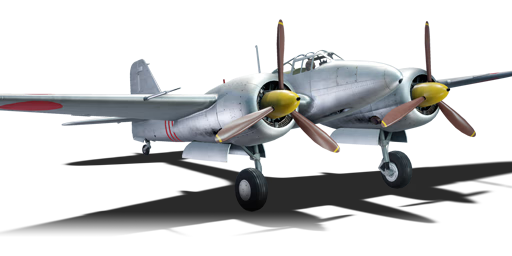


The Ki-96 was a twin-engined heavy fighter developed by Kawasaki as a private venture in 1942 after the success of their Ki-45 line. Like the Ki-45, it was a two-seat, twin-engined fighter with larger and more powerful Ha-112 radial engines to replace the Ki-45's Ha-104 engines. However, as the Japanese Army showed interest in the plane, they requested the plane as a single-seat interceptor, which resulted in two of the three prototypes being built with a smaller cockpit canopy, leaving the first with a two-seat-sized canopy for a single seat. The Ki-96 demonstrated excellent performance and handling, exceeding the estimates, but the Army changed its requirements back to a two-seat fighter, so the project was cancelled. The wings and tail unit of the Ki-96 were used for the Ki-102 two-seat fighter. The Ki-96 was armed with one 37 mm Ho-203 cannon and two 20 mm Ho-5 cannons mounted in its nose.
The Ki-96 was introduced in Update 1.35. Based on the latter 2 prototypes (most likely No.3), it has a smaller single-seat canopy, the Ki-96 is beyond what the Army initially requested. A twin-engine single-seat interceptor-fighter with great performance and handling, it will perform its role of interceptor to its full potential in tearing apart bombers from oblique angles, and outfighting enemy fighters in Boom-N-Zoom tactics. While it's a twin-engine aircraft, it's deceivingly agile and will be capable of dogfighting with single-engine aircraft. One last thing to note is while the armament packs a punch, ammunition is relatively scarce and should be used sparingly with trigger discipline.
flaps
flaps
flaps
brake
| Belt | Belt filling | Armor penetration (mm) at a distance: | |||||
|---|---|---|---|---|---|---|---|
| 10 m | 100 m | 500 m | 1000 m | 1500 m | 2000 m | ||
| HEFI-T/P | 26 | 25 | 20 | 15 | 12 | 9 | |
| P | 26 | 25 | 20 | 15 | 12 | 9 | |
| HEFI-T | 3 | 3 | 3 | 3 | 3 | 3 | |
| Belt | Belt filling | Armor penetration (mm) at a distance: | |||||
|---|---|---|---|---|---|---|---|
| 10 m | 100 m | 500 m | 1000 m | 1500 m | 2000 m | ||
| HEF-I/P/AP-T | 27 | 25 | 17 | 10 | 6 | 4 | |
| HEF-I/HEF-I/AP-T | 27 | 25 | 17 | 10 | 6 | 4 | |
| AP-T/AP-T/HEF-I | 27 | 25 | 17 | 10 | 6 | 4 | |
| AP-T | 27 | 25 | 17 | 10 | 6 | 4 | |
| HEF-I/HEF-I/HEF-I/P | 16 | 13 | 8 | 6 | 0 | 0 | |







 2 x (80 / 225 / 345) %
2 x (80 / 225 / 345) % 
 2 x 148 %
2 x 148 % 

Flight performance | |
|---|---|
Survivability |
|---|
Weaponry | |
|---|---|